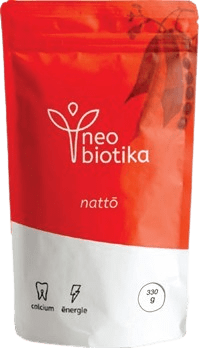NATTO – THE WONDER FOOD SUPPORTED BY SCIENTIFIC INVESTIGATION

NATTO, the traditional Japanese fermented food with probiotic properties became in the last two decades subject of many scientific investigations. This investigation impulse was motivated by the positive health results observed in the populations consuming regularly natto.
Here are given the main facts for a better health supported by the scientific research across the world.
Because bacteria have no intestines, the enzymes necessary for the extraction of nutrients are excreted directly into the food. The fermentation process in the production of natto is a digestion of the steamed soy grains by the enzymes Bacillus subtilis natto produces. Thus, we may say that natto is a pre-digested food, therefore very easy to assimilate.
The research found that regular ingestion of natto increases the size and number of the intestinal villi[1], [2], and consequently increases the assimilation of nutrients present in the daily foods[3]. This process happens not only in young organisms, but even in old ones, and this is very important, because as we progress in age, such nutrients as calcium, magnesium, zinc, potassium, and other vital minerals and vitamins are less and less assimilated, and consequently their deficiencies increase[4]. These deficiencies heighten the probability of diseases and degeneration. Once ingested, the natto enzymes remain active and help in the digestion of other foods, facilitating and increasing the efficiency of our digestion. Using regularly natto, our body spends less energy in the digestion process, and the saved energy may be used for other vital functions, such as neutralizing toxins and free radicals, and healing.
One of these enzymes is NATTOKINASE, a serine protease that passes active from the intestines into the blood.
We should put emphasis on the fact that one of the main initiators of cardio-vascular diseases is the loss of normal blood fluidity. This is related to a less active plasmin, the enzyme in our body in charge with maintaining more fluid (thin) blood, and in dissolving blood clots. A thick blood was shown to be involved in the increase of blood pressure, and in the initiation of endothelial lesions and formation of atheroma.
NATTOKINASE, while passing through the intestinal mucosa into the blood, activates the tPA (tissue plasminogen activator) and thus formation of active plasmin, our natural system for maintaining a healthy fluid blood, and to dissolve blood clots[5], [6], [7], [8],[9]. It is worthy to mention that in presence of nattokinase, plasmin works again in the same way it used to work while we were children; and this is to be comprised as a blood-cardio-vascular rejuvenation. Nattokinase itself works in tandem with the plasmin, and after ingestion of natto, its highest activity is comprised between the 4th and 6th hour. It is important to keep in mind the fact that plasmin is taken here as example of a metabolic enzyme; nevertheless, several other enzymes, which just as plasmin are less efficient as we get older, are activated, and thus we obtain a better regulation of the metabolic paths necessary to maintain good health.
Research with nattokinase demonstrates that it may help avoid or reduce the probability of deep vein thrombosis, cardiac infarction, pulmonary emboli and stroke. It appears to accomplish this via its fibrinolytic, anti-inflammatory and modulating effect on blood pressure. Studies on hypertension demonstrate an average drop of10.9 % in systolic blood pressure and a 9.7% drop in diastolic blood pressure[10], [11], [12].
Blood clots (thrombi) form when strands of fibrin accumulate in the circulatory system. These clots can cause blockage of blood flow. If blood flow is blocked, the oxygen and nutrients supply to that tissue is cut off and toxic wastes accumulate, driving the cells to what is called apoptosis, the cellular death by suicide.
A thick blood with clots forming can result in myocardial infarction (heart attack), and in the brain it can result in strokes. Another frequent health issue when clots form in legs’ deep veins, is lungs embolism. All these events are serious life-threatening factors.
Here is given a list with various health conditions reported to be associated with or aggravated by high fibrin levels due to deficiency in plasmin activity:
- Angina
- Venous stasis, thrombosis, emboli
- Cardiovascular disease / stroke
- Atherosclerosis
- Fibromyalgia / chronic fatigue
- Claudication
retinal pathology - Hemorrhoids / varicose veins
- Soft tissue rheumatisms
- Muscle spasm
poor healing - Chronic inflammation and pain
- Peripheral vascular disease
- Hypertension
- Tissue oxygen deprivation
- Infertility
- Gynecology conditions (e.g. endometriosis, uterine fibroids)
Natto is also the food containing the highest amounts of ménaquinone known as vitamin K2; it is about 300 to 400% richer than the next food which is goose fat liver. Here you have the list of the richest foods in ménaquinone given in micrograms per 100 grams of food[13], [14]:
FOOD VVIT. K2 (K2 MK-4/100G)
Natto[*] 1103.4 (0% MK-4)
Goose fat liver 369.0 (100% MK-4)
Fermented cheese – old 76.3 (6% MK-4)
Soft fermented cheese 56.5 (6.5% MK-4)
Egg yolk (Nederland) 32.1 (98% MK-4)
Goose tight 31.0 (100% MK-4)
Fresh cheese (whole milk) 24.8 (1.6% MK-4)
Egg yolk (United-States & Canada) 15.5 (100% MK-4)
Butter 15.0 (100% MK-4)
Chicken liver 14.1 (100% MK-4)
This vitamin fulfills a plethora of very important biological functions in the human body. Among these functions we find activation of the matrix GLA protein (mgp), which maintains elasticity of arterial walls, of ligaments, tendons, cartilages, skin, and of all conjunctive tissues that should be mechanically resistant and keeping suppleness[15]. The mgp is in charge with the elimination of minerals, such as calcium, otherwise these tissues would become hard as bones[16], [17],[18].
In bones, there is another protein that needs ménaquinone to be active; this is the osteocalcin, which does just the opposite of mgp – it stocks minerals, mainly calcium and magnesium for the normal mineralization of bones and teeth. Also, ménaquinone increases the production of protein fibres inside the bone structures, making them resistant to mechanical shocks, in the same way carbon fibres increase mechanical resistance in materials with low weight but high resistance[19], [20], [21],[22].
Menaquinone was shown to be implicated in preventing and healing cancers[23], [24], [25] and leukemia[26], and in the control of inflammations[27]. Brain, pancreas, bone marrow, are organs that contain the highest concentration of menaquinone. When menaquinone is not in adequate amounts these organs begin to have health issues, and cancer may be one of them.
Natto is also the best source of pyrroloquinoline quinone (PQQ)[28] and one of the richest foods in coenzyme Q9 and Q10[29].
As we age, or in disease, mitochondria, our cellular energy providers, get damaged and become less and less efficient in producing energy. The best picture of the situation is the vivid difference between a 9 years old child, who jumps and runs all day, just for fun, and the 90 years old man or woman, who has pain in rising from bed or making few steps.
Well, PQQ in synergy with CoQ9and 10, can repair and rejuvenate mitochondria in all our cells, including in heart, and brain[30], [31], [32],[33].
Imagine what would be a city without enough energy. Huge problems would appear in vital functions, such as transportation, construction and maintenance, distribution of food, water, and all the necessary goods, but also disposal of wastes (garbage) that would accumulate to insanity and increase the risk of diseases… Same laws reign in our cells, tissues and organs – without enough energy disease is unavoidable and death is the issue shortly after.
When someone is taking regularly natto, one of the most impressive results is an important boost in energy, besides a better blood flow to all parts of the body. Assimilation of nutrients is increased, thus all the necessary materials for bodily maintenance and good health are present, the energy necessary for building and repairing of cellular and tissues structures is boosted, wastes are better eliminated, not only because of a substantial increase in energy, but also because a better blood flow nourishes the whole body and takes away poisonous wastes[34], thus insuring health and wellbeing. In fact, after a short while of regular intake of natto one feels as good as several years ago, when much younger – this is not only a feeling, it is real, the whole body works as used to work when much younger[35]. This is what we may out of doubt call REJUVENATION.
Is there something that can increase the efficiency of NATTO?
Sure, a good hygiene of life – healthy food, healthy physical activity, healthy sleeping, healthy thoughts and spirituality, and some other vitamins, such as D3, B12, some magnesium and potassium, maybe some sea weeds, such as kelp… and a positive mind. Keep the mind keen on information… there is so much information not only in the UNIVERS, but here, on EARTH, and it is really worthy to pay attention to information around the corner or the one in your garden.
Cornelius G. Bulik, B.Sc., M.Sc.

